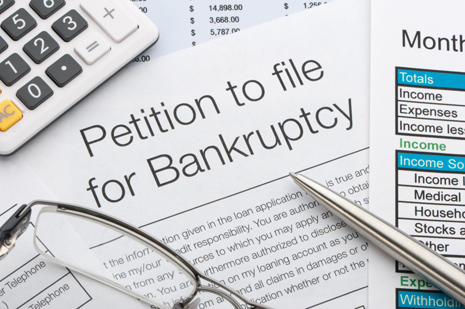Myths and Shame Keep Many from Seeking Bankruptcy Protection

The bankruptcy process determines whether a debtor can pay all debts and still have enough money for the basic necessities for living. It is also an attempt to recover the productive capacity of the debtor.
FAYETTEVILLE, Ark. – Two interesting facts that may counter modern ideas about bankruptcy: The overwhelming majority of U.S. filings belong to individuals rather than corporations or entities, and most of these people wait far too long to seek bankruptcy protection. These are two of many cultural misconceptions associated with bankruptcy in the United States, says Tim Tarvin, associate professor and supervising attorney in the student-staffed Federal Practice Clinic at the University of Arkansas School of Law.
“It’s very sad,” Tarvin says. “It's not unusual for people to break down in the interview setting with the student attorneys who are representing them. These families have been working so hard trying to figure out how to pay off their debt, and it’s just not working. The cash just doesn’t flow. The money isn’t there, and in most cases, it hasn’t been there for a long time.”
As evidence that people wait too long, Tarvin refers to statistics in The Two Income Trap, a book written by Harvard law professor Elizabeth Warren and published in 2003. According to Warren half of all bankrupt families were unwilling to admit, even in an anonymous survey, that they had filed for bankruptcy. She went on to say that as many as 18 million households – compared to the 1.5 million that actually filed in 2003 – would have seen a significant improvement in their balance sheets if they were only willing to sign a bankruptcy petition.
Tarvin attributes this unwillingness to general misconceptions about bankruptcy and one powerful deterrent: shame. This single trait sometimes forces people to go “underground,” meaning they work for cash only, purchase with cash only and then cannot borrow money for any reason or even open a bank account. This usually comes after there has been some kind of legal judgment against them.
“Very often and for whatever reason, there is tremendous shame,” Tarvin says. “For many of our clients, it’s against the tenets of their religion, despite Deuteronomy.”
When counseling clients struggling with these issues, Tarvin will invoke the Biblical passage, part of which states that “at the end of every seven-year period you shall have a relaxation of debts” and “every creditor shall relax his claim on what he has loaned his neighbor.” Because it was rooted in ancient Hebrew and Roman cultural traditions, which valued the recovery of productive capacity of the debtor rather than punishment, despite the creditor’s loss, this passage provides Tarvin with a historical context for explaining the real purpose of bankruptcy.
The real purpose then, according to Tarvin, is not to shame the debtor but rather to simply determine whether he or she can pay. It is a process designed to determine whether the debtor can pay all debts and still have enough money for the basic necessities for living.
“To blame bankruptcy for the debtor’s insolvency and non-payment to the creditor is like blaming the coroner for the death,” Tarvin says. “He – the coroner – is simply pronouncing that the person is deceased. Likewise, a bankruptcy discharge issued by the judge is merely a determination that the debtor is financially unable to pay his debts.”
As Tarvin alluded to above, clients who come into the federal clinic represent a demographic that destroys two other myths that Warren addresses, the myth of the immoral debtor and the over-consumption myth. Warren found that 87 percent of families with children cite only three reasons for bankruptcy: job loss, family breakup and medical problems. Bad investment and credit card overspending are included with “all other reasons” within the remaining 13 percent. Tarvin admits that some clients who come into the federal clinic have reached a financial condition that necessitates bankruptcy because they were irresponsible with credit cards, but these people are a minority.
By far, individuals rather than businesses file the greater number of bankruptcies in federal courts each year. In 2010 there were nearly 1.6 million total filings. Only 3.5 percent of these were business filings.
The Federal Practice Clinic is one of many clinical programs in the School of Law Legal Clinic.
Contacts
Tim Tarvin, associate professor
School of Law
479-575-7159,
ttarvin@uark.edu
Matt McGowan, science and research communications officer
University Relations
479-575-4246,
dmcgowa@uark.edu
Headlines
U of A's Inspirational Chorale Makes Its Carnegie Hall Debut
The U of A's Inspirational Chorale took center stage at Carnegie Hall in March, performing under the direction of professor Jeffrey Murdock to a packed audience at the iconic Stern Auditorium.
The State of Economics With Mervin Jebaraj Set for June 5
U of A economist Mervin Jebaraj will analyze state's economic trends and regional issues in an upcoming talk. Preregistration is required by May 31.
Faculty Demonstrate Dedication to Student Success Through Teaching Credentials
Eight faculty members from across the U of A have earned the prestigious Association of College and University Educators certification in Effective College Teaching.
Artificial Intelligence, Machine Learning Boost Arkansas Animal Science Research
Aranyak Goswami, a bioinformatics specialist, will work with three different departments to boost the research arm of the U of A System Division of Agriculture.
College of Education and Health Professions Doctoral Student Picked for Grosvenor Fellowship
Jessica Culver, a doctoral student in the College of Education and Health Professions Adult and Lifelong Learning program, has been selected as a member of the 2024 Grosvenor Teacher Fellowship.




